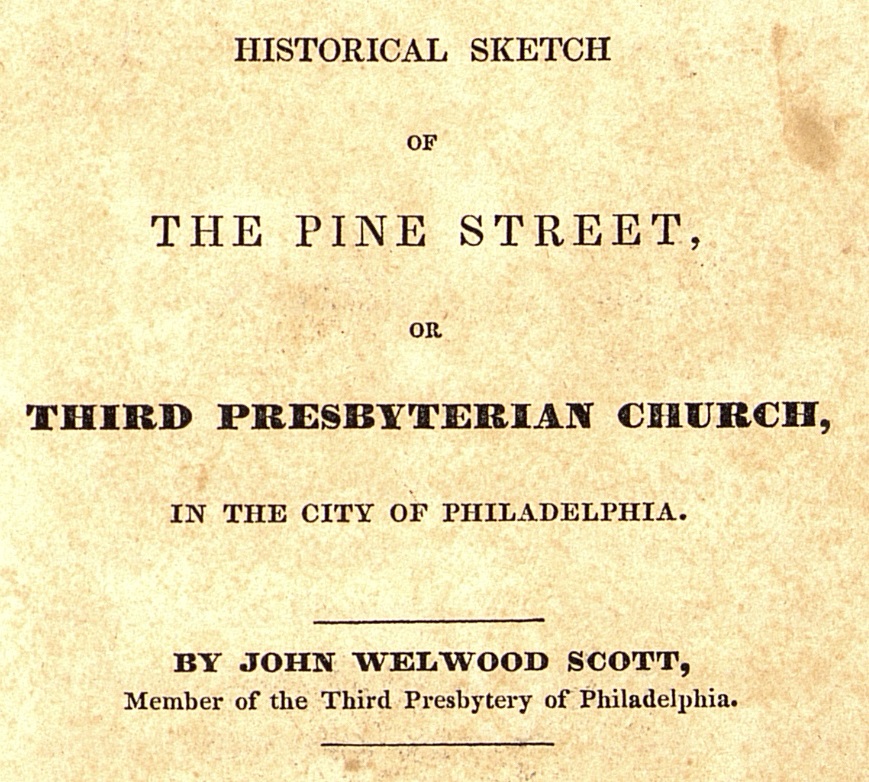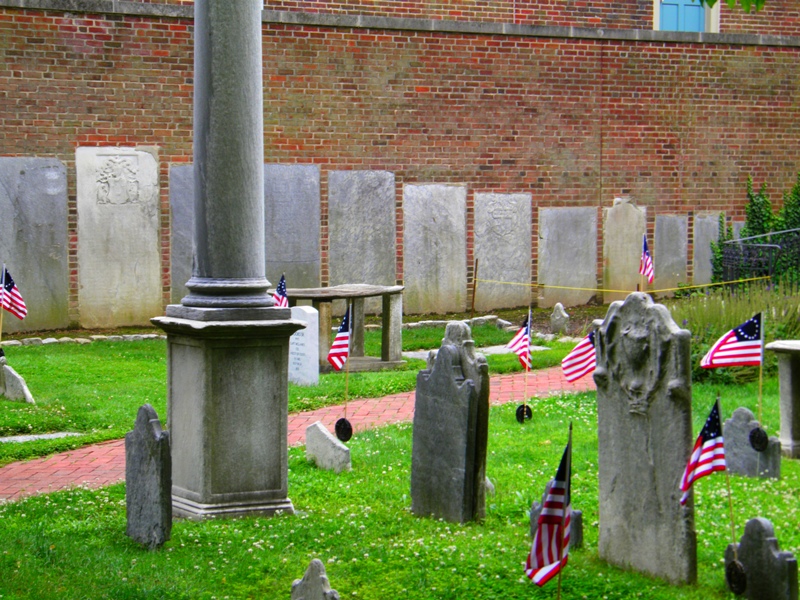Lydia Bailey, 19th Century Printer

Bound tight in a wrap of worn scarlet-leather, the thin little book hid snug, sandwiched between an assortment of larger, to-be-cataloged books with unexceptional covers and designs. I’d plucked the random selection off the mint-green shelving unit where they, like hundreds of other books, stood staged, awaiting my cataloguing attention. As I’d done every workday prior, I planned to catalog and make available in our database, Calvin, more of the hundreds of titles awaiting processing.
Back in my white-walled office, I placed the book tower on my desk, then stood at my computer, completing catalog records. I worked from top down, one book after the next, through the next-to-teetering stack of 19th century publications. I worked with care, but the lackluster nature of the bindings and the dry titles of the books I was cataloguing that morning left me feeling uninspired—until I unearthed the thin scarlet-cover-bound volume.

How pretty! My eyes brightened as I turned the little book round in an effort to examine the detail of the damask-like tooled pattern on its cover. Then, in tiny type on its thin decorative spine, I noted the golden glow of three printed words: "Pine Street Book."
I turned to the title page:

Okay, I thought. The book was about the historic church, Old Pine, whose property shares a border with PHS.
I next looked at the publisher's location: Philadelphia. Given the city’s long history as one of the colonies’—then nation’s—noted publishing centers, there appeared nothing special about this information.
I then typed the early 19th century date, 1837, into the online catalog file before registering that I’d glimpsed the name Lydia in the line attributed to printers and publishers. Coming to an abrupt stop, I returned my gaze to the page. Lydia R. Bailey, it read. A printer in 1837, named Lydia? In my months’ worth of prior cataloguing endeavors, I’d encountered no early American female printers or publishers.
So who was this Lydia Bailey, printer? I prided myself on knowing a lot about Philadelphia’s history and its many historical personages. How had I missed Lydia Bailey? What was her story and was it common for women in early America to own printing businesses? I wondered, paused long, decided that I must find out.
--
According to several online resources, I learned that Lydia Bailey (neé Steel) was born in Lancaster County, PA, in 1779.[1] Further research revealed that her immediate family was one of high social status and financial means. Links to the printing trade were also evident. In the last quarter of the eighteenth century, one of Lydia’s uncles established a profitable paper mill along Octorara Creek and opened a set of printing shops, one in Lancaster and the other in Philadelphia. Also, two of Lydia’s brothers became recognized printers. Furthermore, Lydia, at the age of nineteen, married her cousin, Robert Bailey, who was running his father’s well-established Philadelphia-based printing shop.[2]
From an early age through her married years, Lydia was exposed to various and sundry aspects of the printing craft—folding, stitching, type setting, and the coloring, backing, and varnishing of maps and globes—and trade. As was common for a printer’s wife, Lydia also assisted her husband, Robert, in managing his accounts. By no means did Lydia’s keen memory and accounting aptitude go unnoticed. In fact, Robert admitted that his wife was more accurate and efficient in recording and keeping track of business transactions than he was. Indeed, Lydia’s innate talents, coupled with her wide exposure to the multifaceted and overlapping fields of printing and publishing, would later aid her in becoming a successful master printer.[3]
So who was this Lydia Bailey, printer?...What was her story and was it common for women in early America to own printing businesses?
Robert Bailey died in 1808, leaving Lydia to handle his insolvent business, along with the task of raising their four young children. Thanks to her business acumen, along with her family’s connections and those gained through her marriage, Lydia set about paying off her late husband’s accrued debts and turning the failing business profitable.[4] A strong-willed individual who seems to have been denied any formal educational opportunity, Lydia assumed the role of “master printer”—acting as director and manager of her enterprise—while simultaneously acting as a single parent and running her home.[5] Lydia’s choice to never remarry likely related to her desire to hold steadfast to the professional-business-owning freedoms her widowed status afforded her. Even when her son came of age, Lydia refused to hand him control of the business—remaining its leader until retiring over fifty years later, in 1861.[6]
As I continued reading, I found it interesting to note that while few women in Philadelphia acted as master printers, and while none appears to have been as successful or prolific as Lydia, the fact that Lydia was a business owner made her anything but an anomaly in early Philadelphia’s history. The city was, indeed, teeming with single, primarily widowed, female proprietors, “femes soles” acting as everything from seamstresses, innkeepers, midwives, shopkeepers, butchers, and grocers.[7] To speak only of the printing profession in America, Lydia was preceded by twenty-three female printers, twenty-one of whom had also entered the business as widows.[8] Moreover, women had a long history in the field of European printing and book publishing (although they were not typically master printers), dating back to the 15thcentury.

During my initial, online search into the life of Lydia Bailey, I also learned that she was the first and only female to be appointed City Printer of Philadelphia.[9] Additional research revealed her family connections to have been fortuitous, almost assuring her a degree of professional success, including her election to the city appointment. Within five years of her husband’s passing, Lydia’s uncle, John Steel, was elected to Philadelphia’s City Council. Through his post, he assisted Lydia in winning—and retaining for years to come—the city printer position,[10] a prestigious municipal appointment that proved financially lucrative and helped Lydia secure contracts with notable railroad companies and banks, and institutions, including the University of Pennsylvania, The Library Company of Philadelphia, and the Philadelphia Athenaeum. Moreover, Lydia’s surviving account books reveal her to have completed hundreds, if not thousands of jobs for private and non-profit sector organizations, in addition to jobs for women and women-run or -related charities and enterprises—the diversity of which secured her a steady, if not prodigious, income for the time period.[11] It was by diversifying (in terms of clientele and types of work completed) and refusing to specialize in printing one kind of subject matter (such as educational materials) that Lydia ensured her longstanding success.[12]
As a PHS employee, I was intrigued to learn that Lydia was a pious Presbyterian and member of our neighbor congregation, Third Pine (Old Pine). While Lydia’s religious affiliation assured her contracts with her church, and with the Presbyterian Church in the U.S.A. General Assembly, it is important to recognize that she also conducted business with those of other faiths. For example, she printed works for the Swedesborgian and Catholic churches as well as for Quakers and Jewish charitable organizations.[13]

Not surprisingly, being a devout Presbyterian played a role in shaping the culture of the workplace Lydia ran. While reports show her to have been a benevolent employer, she is also said to have been a strict judge of her apprentices's, journeymen’s, and other employees’ respective senses of morality, insisting that every employee attend church and dismissing those who would not comply with her standards and further her shop’s moral reputation.[14] Late in her life, Lydia refused to sell one of the many properties she’d amassed to a prospective buyer who wanted to open a tavern across the street from her beloved Third Pine.[15]
While few women in Philadelphia acted as master printers...the fact that Lydia was a business owner made her anything but an anomaly in early Philadelphia’s history.
Lydia Bailey registered a formidable eighty-two years of age when she retired in 1861, following the death of her son. The business she closed was by then an anachronism amidst a city full of printers who had modernized their shops, adopting new technologies, and turning from the apprenticeship system to that of a standard wage model. Despite bowing out of the Philadelphia printing scene, Lydia left behind a notable legacy of printed matter, the extent of which is not possible to calculate today. She is also credited with training over forty men in the printing trade, many of whom went on to hold notable positions or to make names for themselves in Philadelphia’s thriving print and publishing sphere.[16] Moreover, Lydia stands as an historic example of a shrewd, business-savvy single mother who not only turned around a failing business, but also came to hold a noted and respected position in a male-dominated society.
--
Today, one can find innumerable artifacts of Lydia Bailey's labor in collections like those at PHS, where we hold one book and a selection of pamphlets that she is responsible for having printed. If one is keen to go on something of an adventure, one can also seek, as I did, to locate Lydia's grave site within Old Pine's cemetery (stay tuned for my upcoming story regarding my not-so-straightforward quest to find Lydia's tombstone!). For me, it is exciting to think that this successful female printer spent time in and around my workplace and otherwise traveled about one of the oldest parts of my home city.

I am grateful to the thin little book with the scarlet leather binding. Had it not been there in my stack of volumes to catalog, I might never have come to know Lydia R. Bailey, Printer, Philadelphia.





















